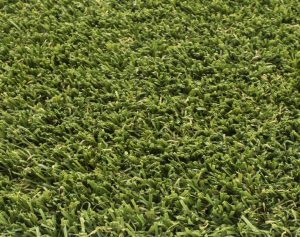Heavy rain, low light and mossy lawns – it’s all part of living in the North West. From Lancashire and Greater Manchester to Cheshire and the West Yorkshire hills, homeowners face constant battles with waterlogged soil, shaded patches and fast-growing moss. Artificial grass is often the simplest, most durable fix – but only when it’s installed with the right base and aftercare.
🔑 Key Takeaways
- Proper drainage and UV-stable fibres keep artificial grass looking fresh in wet, shaded gardens.
- Moss can grow on surface debris – regular brushing and rinsing prevent it from taking hold.
- Choosing quality turf and professional installation ensures your lawn survives the North West climate for years.
🧭 Jump to:
Rain and Drainage – The North West Reality
We get a lot of rain – there’s no way around it. But artificial lawns handle it far better than traditional turf when installed correctly. At As Good As Grass, we always use a compacted MOT Type 1 base topped with sharp sand or limestone fines. This combination locks together tightly yet allows free drainage, so water never sits on the surface.
For wetter spots – think Burnley, Rossendale and Wigan – we sometimes install perforated drainage pipes beneath the sub-base. It’s a small step that makes a big difference to long-term performance.
Dealing with Shade and Low Sunlight
North-facing gardens and those bordered by fences or tall trees rarely see much sunlight. While real grass struggles and turns patchy, synthetic turf stays green all year. UV-stabilised fibres prevent fading and discolouration, even in damp or shady corners.
We often use denser, mid-pile turf like Omneo or Sol Plus for shaded gardens in Bury and Bolton. These retain warmth and shape while offering a softer, more natural feel underfoot – ideal for family and pet use.
Preventing Moss and Algae Build-Up
Moss and algae don’t grow in artificial grass – they form on top when debris, leaves or soil accumulate. A quick brush every few weeks keeps the pile clean and upright, while allowing rainwater to wash through naturally. If moss does appear, it can be removed using a mild moss-killer or diluted vinegar solution (never bleach).
Our maintenance service covers full deep-cleans, power-brushing and re-sand levelling. We’ve restored 10-year-old lawns in Preston and Chorley to near-new condition – a good reminder that proper upkeep extends lifespan dramatically.
Pet-Friendly Performance in Wet Gardens
For dog owners, constant rain can turn gardens into muddy chaos. Our pet-friendly artificial grass includes non-absorbent backing and efficient drainage channels, so puddles disappear fast and odours don’t linger. A quick rinse after use keeps everything hygienic, even in the wettest months.
We also advise against sand infills for pet lawns – they retain moisture and can hold smells. Instead, we use free-draining, non-infill systems ideal for shaded or enclosed yards.
Maintenance: Little Effort, Big Return
Unlike natural turf, you don’t need to mow, fertilise or re-seed. But even synthetic lawns benefit from light, regular care. Brush against the grain every month or two to lift the pile and remove surface debris. Rinse after heavy storms to clear silt or pollen. For shaded gardens, an occasional anti-moss treatment in spring helps keep the fibres bright.
Need help? Our team provides scheduled maintenance and repair visits across the region, including Manchester, Rossendale and Preston.
FAQs – Artificial Grass in Wet or Shaded Gardens
Will rain damage artificial grass?
No – artificial grass is fully porous. Rain drains through the backing and sub-base, preventing puddles or waterlogging when installed properly.
Can moss grow on artificial grass?
Only on trapped debris. Regular brushing prevents it. If it appears, mild moss-killer or vinegar-based cleaners remove it safely.
What type of grass is best for shaded gardens?
Dense, mid-pile turf (20–30 mm) with UV-stable fibres performs best – it stays soft and bright even without direct sunlight.
Do I need to treat artificial grass for moss?
Not often. Preventative brushing is usually enough. For persistent moss, apply a gentle, pet-safe treatment once or twice a year.
Is artificial grass suitable for North West weather?
Absolutely. It’s designed for heavy rain, shade and daily use. Our installation process ensures every lawn drains efficiently and stays neat year-round.
Artificial Grass Built for the North West Climate
Whether you’re in Lancashire, Manchester or Cheshire, we design installations that handle rain, shade and moss with ease. Our drainage systems and UV-resistant turf guarantee a clean, low-maintenance garden all year.
See our Artificial Grass Cost Guide or request a free site survey today.



